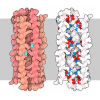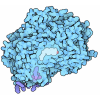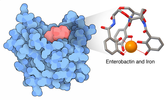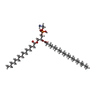[English] 日本語
 Yorodumi
Yorodumi- PDB-8dew: Cryo-electron microscopy structure of Neisseria gonorrhoeae multi... -
+ Open data
Open data
- Basic information
Basic information
| Entry | Database: PDB / ID: 8dew | |||||||||||||||||||||||||||||||||||||||||||||||||||||||||||||||||||||
|---|---|---|---|---|---|---|---|---|---|---|---|---|---|---|---|---|---|---|---|---|---|---|---|---|---|---|---|---|---|---|---|---|---|---|---|---|---|---|---|---|---|---|---|---|---|---|---|---|---|---|---|---|---|---|---|---|---|---|---|---|---|---|---|---|---|---|---|---|---|---|
| Title | Cryo-electron microscopy structure of Neisseria gonorrhoeae multidrug efflux pump MtrD with LL-37 complex | |||||||||||||||||||||||||||||||||||||||||||||||||||||||||||||||||||||
 Components Components |
| |||||||||||||||||||||||||||||||||||||||||||||||||||||||||||||||||||||
 Keywords Keywords | MEMBRANE PROTEIN / MtrD complex / multidrug efflux pump / Neisseria gonorrhoeae | |||||||||||||||||||||||||||||||||||||||||||||||||||||||||||||||||||||
| Function / homology |  Function and homology information Function and homology informationcytolysis / killing by host of symbiont cells / specific granule / cellular response to peptidoglycan / neutrophil activation / cellular response to interleukin-6 / Antimicrobial peptides / efflux transmembrane transporter activity / cellular response to interleukin-1 / xenobiotic transmembrane transporter activity ...cytolysis / killing by host of symbiont cells / specific granule / cellular response to peptidoglycan / neutrophil activation / cellular response to interleukin-6 / Antimicrobial peptides / efflux transmembrane transporter activity / cellular response to interleukin-1 / xenobiotic transmembrane transporter activity / innate immune response in mucosa / cell projection / lipopolysaccharide binding / specific granule lumen / antimicrobial humoral immune response mediated by antimicrobial peptide / positive regulation of angiogenesis / antibacterial humoral response / tertiary granule lumen / cellular response to tumor necrosis factor / cellular response to lipopolysaccharide / defense response to Gram-negative bacterium / amyloid fibril formation / defense response to Gram-positive bacterium / defense response to bacterium / innate immune response / positive regulation of cell population proliferation / Neutrophil degranulation / extracellular space / extracellular exosome / extracellular region / plasma membrane Similarity search - Function | |||||||||||||||||||||||||||||||||||||||||||||||||||||||||||||||||||||
| Biological species |  Neisseria gonorrhoeae (bacteria) Neisseria gonorrhoeae (bacteria) Homo sapiens (human) Homo sapiens (human) | |||||||||||||||||||||||||||||||||||||||||||||||||||||||||||||||||||||
| Method | ELECTRON MICROSCOPY / single particle reconstruction / cryo EM / Resolution: 2.89 Å | |||||||||||||||||||||||||||||||||||||||||||||||||||||||||||||||||||||
 Authors Authors | Lyu, M. / Yu, E.W. | |||||||||||||||||||||||||||||||||||||||||||||||||||||||||||||||||||||
| Funding support |  United States, 1items United States, 1items
| |||||||||||||||||||||||||||||||||||||||||||||||||||||||||||||||||||||
 Citation Citation |  Journal: Microbiol Spectr / Year: 2022 Journal: Microbiol Spectr / Year: 2022Title: Structural Basis of Peptide-Based Antimicrobial Inhibition of a Resistance-Nodulation-Cell Division Multidrug Efflux Pump. Authors: Meinan Lyu / Julio C Ayala / Isabella Chirakos / Chih-Chia Su / William M Shafer / Edward W Yu /  Abstract: Bacterial efflux pumps in the resistance-nodulation-cell division (RND) family of Gram-negative bacteria contribute significantly to the development of antimicrobial resistance by many pathogens. In ...Bacterial efflux pumps in the resistance-nodulation-cell division (RND) family of Gram-negative bacteria contribute significantly to the development of antimicrobial resistance by many pathogens. In this study, we selected the MtrD transporter protein of Neisseria gonorrhoeae as it is the sole RND pump possessed by this strictly human pathogen and can export multiple antimicrobials, including antibiotics, bile salts, detergents, dyes, and antimicrobial peptides. Using knowledge from our previously published structures of MtrD in the presence or absence of bound antibiotics as a model and the known ability of MtrCDE to export cationic antimicrobial peptides, we hypothesized that cationic peptides could be accommodated within MtrD binding sites. Furthermore, we thought that MtrD-bound peptides lacking antibacterial action could sensitize bacteria to an antibiotic normally exported by the MtrCDE efflux pump or other similar RND-type pumps possessed by different Gram-negative bacteria. We now report the identification of a novel nonantimicrobial cyclic cationic antimicrobial peptide, which we termed CASP (ationic ntibiotic-ensitizing eptide). By single-particle cryo-electron microscopy, we found that CASP binds within the periplasmic cleft region of MtrD using overlapping and distinct amino acid contact sites that interact with another cyclic peptide (colistin) or a linear human cationic antimicrobial peptide derived from human LL-37. While CASP could not sensitize Neisseria gonorrhoeae to an antibiotic (novobiocin) that is a substrate for RND pumps, it could do so against multiple Gram-negative, rod-shaped bacteria. We propose that CASP (or future derivatives) could serve as an adjuvant for the antibiotic treatment of certain Gram-negative infections previously thwarted by RND transporters. RND efflux pumps can export numerous antimicrobials that enter Gram-negative bacteria, and their action can reduce the efficacy of antibiotics and provide decreased susceptibility to various host antimicrobials. Here, we identified a ationic ntibiotic-ensitizing eptide (CASP) that binds within the periplasmic cleft of an RND transporter protein (MtrD) produced by Neisseria gonorrhoeae. Surprisingly, CASP was able to render rod-shaped Gram-negative bacteria, but not gonococci, susceptible to an antibiotic that is a substrate for the gonococcal MtrCDE efflux pump. CASP (or its future derivatives) could be used as an adjuvant to treat infections for which RND efflux contributes to multidrug resistance. | |||||||||||||||||||||||||||||||||||||||||||||||||||||||||||||||||||||
| History |
|
- Structure visualization
Structure visualization
| Structure viewer | Molecule:  Molmil Molmil Jmol/JSmol Jmol/JSmol |
|---|
- Downloads & links
Downloads & links
- Download
Download
| PDBx/mmCIF format |  8dew.cif.gz 8dew.cif.gz | 996.2 KB | Display |  PDBx/mmCIF format PDBx/mmCIF format |
|---|---|---|---|---|
| PDB format |  pdb8dew.ent.gz pdb8dew.ent.gz | 835 KB | Display |  PDB format PDB format |
| PDBx/mmJSON format |  8dew.json.gz 8dew.json.gz | Tree view |  PDBx/mmJSON format PDBx/mmJSON format | |
| Others |  Other downloads Other downloads |
-Validation report
| Summary document |  8dew_validation.pdf.gz 8dew_validation.pdf.gz | 1.8 MB | Display |  wwPDB validaton report wwPDB validaton report |
|---|---|---|---|---|
| Full document |  8dew_full_validation.pdf.gz 8dew_full_validation.pdf.gz | 1.9 MB | Display | |
| Data in XML |  8dew_validation.xml.gz 8dew_validation.xml.gz | 98.2 KB | Display | |
| Data in CIF |  8dew_validation.cif.gz 8dew_validation.cif.gz | 147.2 KB | Display | |
| Arichive directory |  https://data.pdbj.org/pub/pdb/validation_reports/de/8dew https://data.pdbj.org/pub/pdb/validation_reports/de/8dew ftp://data.pdbj.org/pub/pdb/validation_reports/de/8dew ftp://data.pdbj.org/pub/pdb/validation_reports/de/8dew | HTTPS FTP |
-Related structure data
| Related structure data |  27401MC  8deuC  8devC M: map data used to model this data C: citing same article ( |
|---|---|
| Similar structure data | Similarity search - Function & homology  F&H Search F&H Search |
- Links
Links
- Assembly
Assembly
| Deposited unit | 
|
|---|---|
| 1 |
|
- Components
Components
| #1: Protein | Mass: 113932.469 Da / Num. of mol.: 3 Source method: isolated from a genetically manipulated source Source: (gene. exp.)  Neisseria gonorrhoeae (bacteria) / Gene: mtrD / Production host: Neisseria gonorrhoeae (bacteria) / Gene: mtrD / Production host:  #2: Protein/peptide | | Mass: 2050.516 Da / Num. of mol.: 1 Source method: isolated from a genetically manipulated source Source: (gene. exp.)  Homo sapiens (human) / Gene: CAMP, CAP18, FALL39, HSD26 / Production host: Homo sapiens (human) / Gene: CAMP, CAP18, FALL39, HSD26 / Production host:  #3: Chemical | ChemComp-PTY / Has ligand of interest | N | Has protein modification | N | |
|---|
-Experimental details
-Experiment
| Experiment | Method: ELECTRON MICROSCOPY |
|---|---|
| EM experiment | Aggregation state: PARTICLE / 3D reconstruction method: single particle reconstruction |
- Sample preparation
Sample preparation
| Component | Name: Multidrug efflux pump MtrD with LL37 (17-32) peptide complex Type: COMPLEX / Entity ID: #1-#2 / Source: MULTIPLE SOURCES | ||||||||||||
|---|---|---|---|---|---|---|---|---|---|---|---|---|---|
| Source (natural) |
| ||||||||||||
| Source (recombinant) | Organism:  | ||||||||||||
| Buffer solution | pH: 7.5 | ||||||||||||
| Specimen | Conc.: 0.7 mg/ml / Embedding applied: NO / Shadowing applied: NO / Staining applied: NO / Vitrification applied: YES | ||||||||||||
| Vitrification | Cryogen name: ETHANE |
- Electron microscopy imaging
Electron microscopy imaging
| Experimental equipment |  Model: Titan Krios / Image courtesy: FEI Company |
|---|---|
| Microscopy | Model: FEI TITAN KRIOS |
| Electron gun | Electron source:  FIELD EMISSION GUN / Accelerating voltage: 300 kV / Illumination mode: FLOOD BEAM FIELD EMISSION GUN / Accelerating voltage: 300 kV / Illumination mode: FLOOD BEAM |
| Electron lens | Mode: BRIGHT FIELD / Nominal defocus max: 2250 nm / Nominal defocus min: 1000 nm / C2 aperture diameter: 100 µm |
| Image recording | Average exposure time: 2.6 sec. / Electron dose: 40 e/Å2 / Film or detector model: GATAN K3 (6k x 4k) / Num. of grids imaged: 1 / Num. of real images: 8728 |
- Processing
Processing
| Software | Name: PHENIX / Version: 1.19.2_4158: / Classification: refinement | ||||||||||||||||||||||||
|---|---|---|---|---|---|---|---|---|---|---|---|---|---|---|---|---|---|---|---|---|---|---|---|---|---|
| EM software | Name: PHENIX / Category: model refinement | ||||||||||||||||||||||||
| CTF correction | Type: PHASE FLIPPING AND AMPLITUDE CORRECTION | ||||||||||||||||||||||||
| 3D reconstruction | Resolution: 2.89 Å / Resolution method: FSC 0.143 CUT-OFF / Num. of particles: 428882 / Symmetry type: POINT | ||||||||||||||||||||||||
| Refine LS restraints |
|
 Movie
Movie Controller
Controller




 PDBj
PDBj





